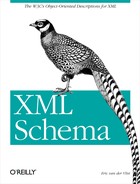Name
xs:element(reference or local definition) — Reference to a global element declaration or local definition (local definitions cannot be referenced).
Synopsis
<xs:element
block = ( “#all” | list of ( “extension” | “restriction” |
“substitution” ) )
default = xs:string
fixed = xs:string
form = ( “qualified” | “unqualified” )
id = xs:ID
maxOccurs = ( xs:nonNegativeInteger | “unbounded” ) : “1”
minOccurs = xs:nonNegativeInteger : “1”
name = xs:NCName
nillable = xs:boolean : “false”
ref = xs:QName
type = xs:QName
{any attributes with non-schema namespace}
>
Content: (xs:annotation?, (xs:simpleType | xs:complexType)?, (xs:unique |
xs:key | xs:keyref)*)
</xs:element>
May be included in: xs:choice (outside a group), xs:choice (within a group), xs:sequence (within a group), xs:sequence (outside a group)
Description
This element serves two different purposes and has two different content models for these purposes: it can either be a reference to a globally defined element or to a local element definition. These options are mutually exclusive.
When used as a reference to an element, the ref
attribute must contain the qualified name of the element (with its
namespace prefix).
When used as a local definition, the definition is done by assigning
a simple or complex datatype to the element. This assignment can be
done either by reference, using the type attribute
to refer to a simple or complex datatype by its qualified name, or
inline, by embedding the definition of the simple
(xs:simpleType) element or complex
(xs:complexType) element within the
xs:element element.
In all cases, the number of occurrences can be constrained using the
minOccurs and maxOccurs
attributes, whose default value is 1. The
maxOccurs attribute can take the value unbounded,
to define that an element may appear as many times as the author of
the document wishes.
Restrictions
The default and fixed values are defined in attributes and, therefore, can only apply to simple type elements.
The fact that W3C XML Schema cannot describe the exclusive combinations of the attributes and elements of xs:element which could be summarized as:
ref attribute xor name attribute, type attribute xor xs:simpleType element, xor xs:complexType element
is an example that shows some of the restrictions of the language.
Example
<xs:sequence>
<xs:element name="book" maxOccurs="unbounded">
<xs:complexType>
<xs:sequence>
<xs:element ref="isbn"/>
<xs:element ref="title"/>
<xs:element ref="author" minOccurs="0"
maxOccurs="unbounded"/>
<xs:element ref="character" minOccurs="0"
maxOccurs="unbounded"/>
</xs:sequence>
<xs:attribute ref="id"/>
<xs:attribute ref="available"/>
</xs:complexType>
</xs:element>
</xs:sequence>Attributes
-
block Controls whether the element can be subject to a type or substitution group substitution.
#allblocks any substitution,substitutionblocks any substitution through substitution groups, andextensionandrestrictionblock any substitution (both throughxsi:typeand substitution groups) by elements or types, derived respectively by extension or restriction from the type of the element. Its default value is defined by theblockDefaultattribute of the parentxs:schema.-
default Default value of the element. Defined in an attribute, element default values must be simple contents. Also note that default values apply only to elements that are present in the document and empty. The
fixedanddefaultattributes are mutually exclusive.-
fixed A simple content element may be fixed to a specific value using this attribute. This value is also used as a default value, and if the element is empty, it is supplied to the application. The
fixedanddefaultattributes are mutually exclusive.-
form Defines if the element is “qualified” (i.e., belongs to the target namespace) or “unqualified” (i.e., doesn’t belong to any namespace)—to be used only for local element definitions.
-
id W3C XML Schema’s element ID.
-
maxOccurs Maximum number of occurrences (“unbounded” means “unlimited”).
-
minOccurs Minimum number of occurrences.
-
name Local name (without namespace prefix)—to be use only for local element definitions.
-
nillable When this attribute is set to
true, the element can be declared as nil using anxsi:nilattribute in the instance documents.-
ref Reference to a global element—to be used only for references.
-
type Reference to a simple or complex type—to be used only for local element definitions.
